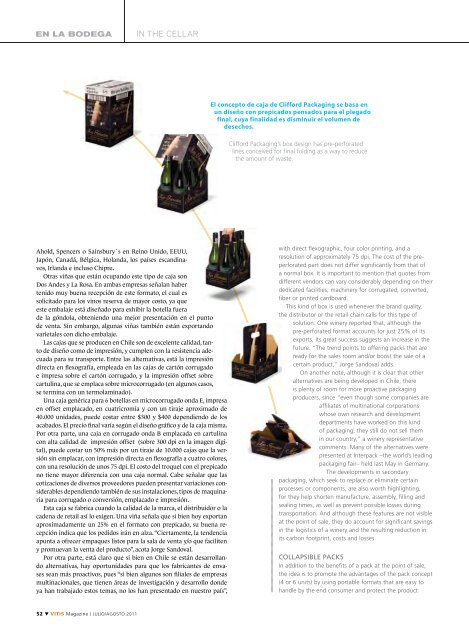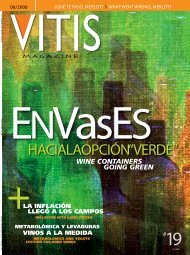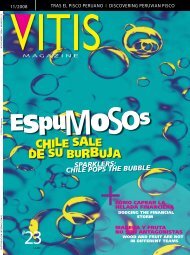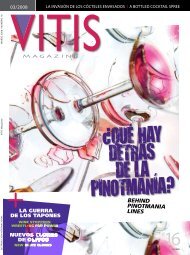VINOS DE PARRAS ANTIGUAS - Vitis Magazine
VINOS DE PARRAS ANTIGUAS - Vitis Magazine
VINOS DE PARRAS ANTIGUAS - Vitis Magazine
You also want an ePaper? Increase the reach of your titles
YUMPU automatically turns print PDFs into web optimized ePapers that Google loves.
en la bodega in the cellar<br />
Ahold, Spencers o Sainsbury´s en Reino Unido, EEUU,<br />
Japón, Canadá, Bélgica, Holanda, los países escandinavos,<br />
Irlanda e incluso Chipre.<br />
Otras viñas que están ocupando este tipo de caja son<br />
Dos Andes y La Rosa. En ambas empresas señalan haber<br />
tenido muy buena recepción de este formato, el cual es<br />
solicitado para los vinos reserva de mayor costo, ya que<br />
este embalaje está diseñado para exhibir la botella fuera<br />
de la góndola, obteniendo una mejor presentación en el punto<br />
de venta. Sin embargo, algunas viñas también están exportando<br />
varietales con dicho embalaje.<br />
Las cajas que se producen en Chile son de excelente calidad, tanto<br />
de diseño como de impresión, y cumplen con la resistencia adecuada<br />
para su transporte. Entre las alternativas, está la impresión<br />
directa en flexografía, empleada en las cajas de cartón corrugado<br />
e impresa sobre el cartón corrugado, y la impresión offset sobre<br />
cartulina, que se emplaca sobre microcorrugado (en algunos casos,<br />
se termina con un termolaminado).<br />
Una caja genérica para 6 botellas en microcorrugado onda E, impresa<br />
en offset emplacado, en cuatricromía y con un tiraje aproximado de<br />
40.000 unidades, puede costar entre $300 y $400 dependiendo de los<br />
acabados. El precio final varía según el diseño gráfico y de la caja misma.<br />
Por otra parte, una caja en corrugado onda B emplacada en cartulina<br />
con alta calidad de impresión offset (sobre 300 dpi en la imagen digital),<br />
puede costar un 50% más por un tiraje de 10.000 cajas que la versión<br />
sin emplacar, con impresión directa en flexografía a cuatro colores,<br />
con una resolución de unos 75 dpi. El costo del troquel con el prepicado<br />
no tiene mayor diferencia con una caja normal. Cabe señalar que las<br />
cotizaciones de diversos proveedores pueden presentar variaciones considerables<br />
dependiendo también de sus instalaciones, tipos de maquinaria<br />
para corrugado o conversión, emplacado e impresión.<br />
Esta caja se fabrica cuando la calidad de la marca, el distribuidor o la<br />
cadena de retail así lo exigen. Una viña señala que si bien hoy exportan<br />
aproximadamente un 25% en el formato con prepicado, su buena recepción<br />
indica que los pedidos irán en alza. “Ciertamente, la tendencia<br />
apunta a ofrecer empaques listos para la sala de venta y/o que faciliten<br />
y promuevan la venta del producto”, acota Jorge Sandoval.<br />
Por otra parte, está claro que si bien en Chile se están desarrollando<br />
alternativas, hay oportunidades para que los fabricantes de envases<br />
sean más proactivos, pues “si bien algunos son filiales de empresas<br />
multinacionales, que tienen áreas de investigación y desarrollo donde<br />
ya han trabajado estos temas, no los han presentado en nuestro país”,<br />
52 ▼ <strong>Vitis</strong> <strong>Magazine</strong> l julio/agosto 2011<br />
El concepto de caja de Clifford Packaging se basa en<br />
un diseño con prepicados pensados para el plegado<br />
final, cuya finalidad es disminuir el volumen de<br />
desechos.<br />
Clifford Packaging’s box design has pre-perforated<br />
lines conceived for final folding as a way to reduce<br />
the amount of waste.<br />
with direct flexographic, four color printing, and a<br />
resolution of approximately 75 dpi. the cost of the preperforated<br />
part does not differ significantly from that of<br />
a normal box. it is important to mention that quotes from<br />
different vendors can vary considerably depending on their<br />
dedicated facilities, machinery for corrugated, converted,<br />
fiber or printed cardboard.<br />
this kind of box is used whenever the brand quality,<br />
the distributor or the retail chain calls for this type of<br />
solution. one winery reported that, although the<br />
pre-perforated format accounts for just 25% of its<br />
exports, its great success suggests an increase in the<br />
future. “the trend points to offering packs that are<br />
ready for the sales room and/or boost the sale of a<br />
certain product,” jorge sandoval adds.<br />
on another note, although it is clear that other<br />
alternatives are being developed in Chile, there<br />
is plenty of room for more proactive packaging<br />
producers, since “even though some companies are<br />
affiliates of multinational corporations<br />
whose own research and development<br />
departments have worked on this kind<br />
of packaging, they still do not sell them<br />
in our country,” a winery representative<br />
comments. Many of the alternatives were<br />
presented at interpack –the world’s leading<br />
packaging fair– held last May in germany.<br />
the developments in secondary<br />
packaging, which seek to replace or eliminate certain<br />
processes or components, are also worth highlighting,<br />
for they help shorten manufacture, assembly, filling and<br />
sealing times, as well as prevent possible losses during<br />
transportation. and although these features are not visible<br />
at the point of sale, they do account for significant savings<br />
in the logistics of a winery and the resulting reduction in<br />
its carbon footprint, costs and losses.<br />
COLLAPSIBLE PACKS<br />
in addition to the benefits of a pack at the point of sale,<br />
the idea is to promote the advantages of the pack concept<br />
(4 or 6 units) by using portable formats that are easy to<br />
handle by the end consumer and protect the product






